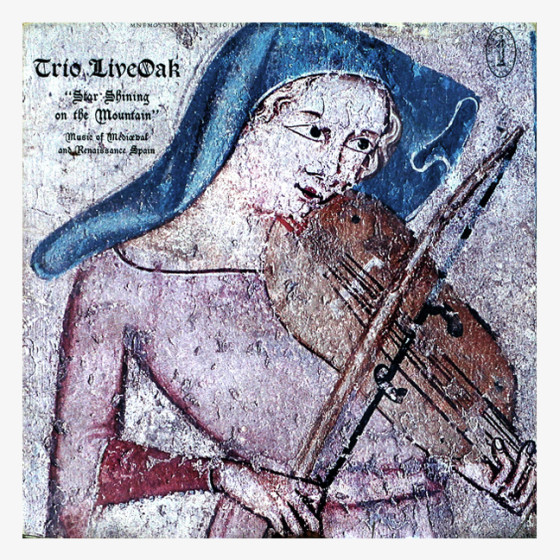Star Shining on the Mountain EP
Trio LiveOak’s first recording, an LP on Mnemosyne Records, is now available to download in high quality MP3s. PLEASE PAY WHAT YOU FEEL THE ALBUM IS WORTH TO YOU – we are thrilled to make this precious recording available to as many lovers of ancient music as we can!
Our first, and one of the most popular recordings LiveOak ever made. Star Shining on the Mountain is full of the youthful vigor that characterized Trio LiveOak, second incarnation of the group after The LiveOak Consort. Performed by John Fleagle, Nancy Knowles and Frank Wallace with voices, vihuela de mano, rebec, oud, flutes, viola da gamba and other instruments
Released: 1980 on Mnemosyne Records (Titanic)
1. Stella splendens in monte
2. Una sañosa porfía
3. Jançu janto
4. La tricotea Samartín la vea
5. Pajarito, pajarito
6. Isabel, perdiste la tu faxa
7. Fantasía #10
8. Scalerica de oro
9. Quen a Virgen Santa/Muit amar devemos
10. La loba parda & la loba merina
11. Ay, que viene dios
12. Niña y viña
13. La pobre mora
14. Si la noche haze escura
15. Ay, linda amiga
16. Falalalanlera
TOTAL TIME: 37:48
This is a review not of the LP, but of a concert of similar material at Music Before 1800 in 1982 in the New York Times.
CONCERT: LIVEOAK, TRIO, LOOKS AT 13TH CENTURY
By EDWARD ROTHSTEIN
Published: November 29, 1982
ONE of the major composers of the Spanish Renaissance, Juan del Encina, took his name from the ”live oak” -an evergreen oak, known for its strength and long life. The tree’s name, which has been used as a verb, meaning ”to revitalize,” has also been taken by the Trio LiveOak, a musical group that played as part of the ”Music Before 1800” series at Corpus Christi Church yesterday afternoon.
In music of the 13th century, the trio lived up to its name. It was a program titled ”An Age of Miracles: The Wonders of Mary and the Wonders of Love.” The players and singers not only revitalized the 700-year-old music, but they also gave it a youthful suppleness and mature solidity, capturing both the sensuous twists and jaunty rhythms of pastoral love and the more serene chants of religious devotion.
In fact, the program was a deliberate and provocative mixture of the secular and the religious, including one motet written for two contradictory texts sung at the same time. One begins: ”The hypocrites, false prelates, hardened killers of the church, clink their goblets in their boozy orgies.” The other insists, ”The deeds of the prelates shine forth like the stars in the heavens.” The music, composed in France toward the beginning of the 13th century, let neither text have the upper hand.
There were also songs, such as the anonymously set motet ”Je Gart le Bois,” a celebration of wooded greenery and its gifts for lovers; ”Son Me Regarde,” a mixture of popular and trouvere settings, and such religious settings as ”O Jesu Salvator” and ”Surrexit de Tumulo.”
These were songs, then, not of the church service, but of the court and secular life. Doctrine and solemnity here becomes legend and wit; written in Gallego-Portuguese, these texts were free to mix belief with cynicism, reverence with physicality.
One genre of works, for example, were popular settings of tales of miracles wrought by the Virgin. ”A Virgen Muy Groriosa” told of a young man who places a ring on the statue of the Virgin for safekeeping while he goes off to play ball. Her hand closes around the ring; she later claims him as her own, drawing him away from his wife and earthly love. Another told of a pregnant abbess, who was delivered of her baby by Mary and thus saved from scandal. Over the folk naivete the anonymous composers wove celebratory and devotional melodies.
The program notes themselves might have been more detailed, but the eloquence of the players could not have been improved upon. The tenor John Fleagle narrated and sang the tale of the ring miracle with a light, flexible voice that subtly adjusted to the text’s changing tones. The soprano Nancy Knowles gave a vocal image of the ”heavenly queen” in ”Royne Celestre” – sturdy, compassionate, serene. And the baritone Frank Wallace, in the final song by the troubadour Riquier, captured the pain of an older man looking about at a fraudulent world to which he has ”come too late.” Meanwhile, in these and other selections, the singers displayed their vocal talents on instruments as well, including varieties of the vihuela, a fiddle, on flutes and on psaltery. This was not historical excavation; the trio presented a thriving musical organism.
